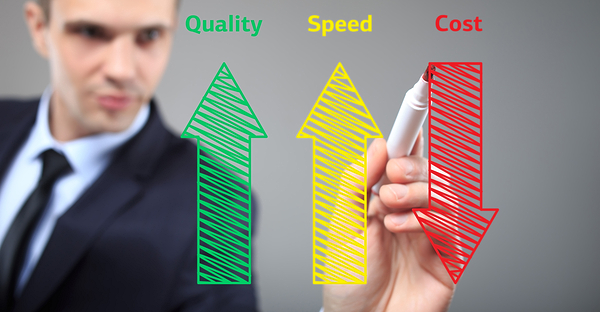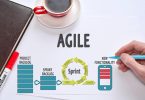By Kenneth Crow – DRM Associates
INTRODUCTION
A competitive product must address factors such as cost, performance, aesthetics, schedule or time-to-market, and quality. The importance of these factors will vary from product to product and market to market. And , over time, customers or users of a product will demand more and more, e.g., more performance at less cost.
Cost will become a more important factor in the acquisition of a product in two situations. First, as the technology or aesthetics of a product matures or stabilizes and the competitive playing field levels, competition is increasingly based on cost or price. Second, a customer’s internal economics or financial resource limitations may shift the acquisition decision toward affordabilityas a more dominant factor. In either case, a successful product supplier must focus more attention on managing product cost.
The management of product cost begins with the conception of a new product. A large percentage of the product’s ultimate acquisition or life cycle costs, typically seventy to eighty percent, is determined by decisions made from conception through product development cycle. Once the design of the product has been established, relatively little latitude exists to reduce the cost of a product. Decisions made after the product moves into production account for another ten to fifteen percent of the product’s costs. Similarly, decisions made about general and administrative, sales and marketing, and product distribution activities and policies account for another ten to fifteen percent of the product’s cost.
When a company faces a profitability problem and undertakes a cost reduction program, it will typically reduce research and development expenditures and focus on post-development activities such as production, sales, and general and administrative expenditures. While not suggesting that these are inappropriate steps to take, the problem is that it is too late and too little. Most of the cost structure in a company has been locked into place with the design decisions made about the company’s products. A cost reduction or profitability program has to start with the design of the company’s products at the very beginning of the development cycle.
DEFINITION OF TERMS
The following definition of terms will provide a common basis for discussion:
- Recurring production cost = production labor + direct materials + process costs + overhead + outside processing
- Non-recurring costs = development costs + tooling
- Product costs = Recurring production costs + allocated non-recurring costs
- Product price or acquisition costs = Product costs + selling, general & administrative + warranty costs + profit
- Life cycle costs = Acquisition costs + other related capital costs + training costs + operating costs + support costs + disposal costs
TRADITIONAL APPROACH
In many companies, product cost or life cycle cost considerations are an afterthought. Costs are tallied up and used as the basis for determining the product’s price. The primary focus is on product performance, aesthetics, or technology. Companies may get by with this approach in some markets and with some products in the short term, but ultimately competition will catch up and the product will no longer be competitive.
In other companies, cost is a more important factor, but this emphasis is not acted upon until late in the development cycle. Projected costs of production are estimated based on drawings and accumulated from quotes and manufacturing estimates. If these projected costs are too high relative to competitive conditions or customers requirements, design changes are made to varying degrees to reduce costs. This may occur before or after the product has been released to production. The result is extended development cycles and added development cost with these design iterations.
In some organizations, development costs receive relatively little attention as well. There may not be a rigorous planning and budgeting process for development projects. Budgets are established without buy-in from development personnel resulting in budget overruns.
Effective product cost management requires a design to cost philosophy as its basis since a substantial portion of the product’s cost is dictated by decisions regarding its design. Design to cost is a management strategy and supporting methodologies to achieve an affordable product by treating target cost as an independent design parameter that needs to be achieved during the development of a product. A design to cost approach consists of the following elements:
- An understanding of customer affordability or competitive pricing requirements by the key participants in the development process;
- Establishment and allocation of target costs down to a level of the hardware where costs can be effectively managed;
- Commitment by development personnel to development budgets and target costs;
- Stability and management of requirements to balance requirements with affordability and to avoid creeping elegance;
- An understanding of the product’s cost drivers and consideration of cost drivers in establishing product specifications and in focusing attention on cost reduction;
- Product cost models and life cycle cost models to project costs early in the development cycle to support decision-making;
- Active consideration of costs during development as an important design parameter appropriately weighted with other decision parameters;
- Creative exploration of concept and design alternatives as a basis for developing lower cost design approaches;
- Access to cost data to support this process and empower development team members;
- Use of value analysis / function analysis and its derivatives (e.g., function analysis system technique) to understand essential product functions and to identify functions with a high cost to function ratio for further cost reduction;
- Application of design for manufacturability principles as a key cost reduction tactic;
- Meaningful cost accounting systems using cost techniques such as activity-based costing (ABC) to provide improved cost data;
- Consistency of accounting methods between cost systems and product cost models as well as periodic validation of product cost models; and
- Continuous improvement through value engineering to improve product value over the longer term.
TARGET COSTING AS A FOUNDATION
Executive management, marketing, program/product managers, and development team personnel all need to have an understanding of customer affordability constraints or competitive market place requirements. Everyday customers buy products with functions, features and performance in excess of their needs and wonder how much is money is wasted on these unneeded capabilities. A keener awareness of design to cost requirements is needed. This happens when product development team members and executive management have direct contact with customers to understand their true needs and hear their sensitivity to costs directly, or when they are exposed to competitor’s product pricing in the market place.
Based on this awareness of customer affordability or design to cost requirements, cost targets should be formally established. These targets should be developed based on pricing formulas and strategies and consideration of price elasticity. Prices and target costs will also have to consider projected production volumes and amortization of non-recurring development costs. In a more complex product or system, the top-level target cost will need to be allocated to lower level subsystems or modules. This will establish a measurable objective for a product development team where multiple teams are involved in a development project.
In an environment where development cost is significant relative to total recurring production costs, more attention will need to be paid to managing these non-recurring development costs. Non-recurring development cost will be a function of the extent of new product and process technology and the extent of use of new materials, parts and subsystems. If product is an evolutionary step with minimal development risk, non-recurring development costs will be lower. The use of standard parts and modules from other existing products will also lower non-recurring development costs. This suggests a strategy of not letting product and process technology application get too far ahead of customer affordability requirements.
Product development team members should buy-in to or commit to these product cost targets and development budgets to improve the chances of meeting these objectives. When empowered product development teams actually develop these budgets and targets, a sense of commitment to these budgets or targets develops. If the budgets or targets are established by someone outside the product development team (e.g., by a product or program manager, a management team, a system integration team, or a project engineer), the targets and budgets should be carefully reviewed with the team members to insure they understand these cost objectives and the assumptions behind them. While competition will generally dictate that stretch goals be established, these goals should be accepted by the team as achievable.
COST MODELS AND COST DATA
Once a team has a set of requirements and a cost target established, they will begin exploring alternatives as part of the design process. In the absence of other information, they will tend to evaluate a product concept primarily based on its performance merits and, at best, secondarily consider a subjective estimate of the relative costs of the design alternatives. Ad-hoc cost studies or trade studies may be prepared for significant issues, but tools to regularly support this process are lacking. Tools and information need to be provided to a product development team so that they can more proactively and objectively consider the cost implications of various design approaches on a regular basis. A product cost model or life cycle cost model provides an objective basis for evaluating design alternatives from a very early stage in the development cycle.
As the organization proceeds through the design of both product and process, the product cost model is used to project and accumulate product costs to use as a factor in evaluating design alternatives and to refine the design to meet cost targets. If it is determined after extensive evaluation that the product requirements cannot be achieved at the target cost, the requirements and targets will need to be re-evaluated and modified.
Early in the development cycle, the product cost model will be based primarily on characteristics of the product design with relatively little consideration of the actual manufacturing process. The model will be driven by general design parameters, product/part characteristics, and critical parameter tolerances. The model will be implicitly based on assumptions about existing processes and process relationships to types of materials, sizes and tolerance requirements.
Later in the development cycle, a different type of product cost model will be used that will consider the specific manufacturing processes. This type of model will be built around existing processes where relatively good historical cost data should exist. On occasion, new manufacturing processes will need to be considered. Data will need to be gathered as a basis for creating or extending the product cost model for the new process(es). Information to support this model development can be obtained from equipment suppliers, other users of this manufacturing process, facility engineers, and manufacturing engineers.
Cost data will also need to be obtained for many purchased parts and sub-assemblies. This information may be available in the form of catalog prices or supplier quotations. However, to support cost projections much earlier in the development cycle, a close working relationship with the company’s supplier base will allow preliminary cost projections to be obtained without the formalized commitment of a quotation. The supplier relationship and company information needs may even develop to the point that the company works with the supplier to develop a supplier cost model based on the supplier’s process capabilities.
A company’s initial attempt with a product cost model may utilize a spreadsheet program or a bill of material cost roll-up capability. The focus is on accumulating and tracking estimated material, part and assembly costs. This summarization capability may start with cost estimates and update the estimates with quoted prices or catalog prices for purchased items or manufacturing’s estimates based on preliminary drawings for fabricated items and assemblies.
Over time, a more sophisticated product cost model should be developed that will project costs based on the characteristics of parts and the overall product design. This type of cost model might be based on commercially available design for manufacturability (DFM) or design for assembly (DFA) software packages. These systems typically generate an estimate of fabrication or assembly labor time and costs or machine cycle time. and costs as part of their capabilities. In addition, there are commercially available cost models that allow a company to develop a custom model of their manufacturing processes and project even more exacting cost estimates based on their product or part characteristics. These individual packages or modules will be oriented toward a limited part or product domain, e.g., manual or automated assembly, printed circuit boards, sheet metal, injection molding, casting, etc. Multiple modules will typically be needed to support overall product cost modeling. In addition, a database reporting capability or spreadsheet will be needed to accumulate the many individual elements of cost from these various cost modeling system components so that effective overall trade-off’s can be made.
Over the course of the development cycle, several different costing tools may be used by an organization. In the early stages of product development, an estimating system may be used to respond to a customer request for quotation or request for proposal or to develop an internal estimate to prepare a cost justification for the development project to management. This cost model would be based on parametric or analogy techniques. Parametric techniques would take general characteristics about the product such as size, weight, number of functions, etc., and use these parameters to develop a general cost estimate. Analogy techniques would take a similar product’s cost and use a “same as except for” approach to develop a cost estimate based on the cost of an existing item.
As the development cycle moves into the product design phase, cost models and DFM/DFA tools as just described would be used. These estimates would be more refined since more is known about the design of the product and its cost drivers. Once the product design is essentially complete, tools and methods such as computer-aided and manual process planning and tools to support the development of labor standards would be used to develop even more refined cost estimates. Finally, as the product moves into production, cost accounting systems would collect costs by product, assembly, part, and operation. These costing tools are illustrated below.
These costing tools should have a consistent basis for accounting for costs and a consistent set of rates. In addition, the organization should establish procedures to periodically validate the cost models by comparing the projected costs with actual costs and adjusting parameters in the model to yield projections closer to actual experience.
In some cases, life cycle costs may need to be considered as the basis for making design decisions. This will add to the complexity of a cost model. Data will need to be gathered on operating costs (e.g., facilities, training, manpower, fuel or energy consumption, etc.), maintenance costs, and disposal costs. While these costs can be modeled, historical data related to operations, reliability and maintenance often is needed. This means that a customer will need to provide this data or that the company have close working relationships with customers where this data is routinely gathered.
To support the operation of these cost models, cost data will need to be readily accessed. Some companies try to restrict access to cost data to prevent this information leaking out to competitors. This restricted access undermines a design to cost methodology and empowerment of the product development teams. This data needs to be made available to support cost modeling. Typical data required will be labor rates, overhead rates, learning curves, efficiencies, historical and projected parts costs, and escalation projections for labor and materials.
Traditional approaches to allocating overhead or burden costs generally based on direct labor. However, direct labor is becoming an insignificant cost component in many products. Further, there is frequently a lack of understanding of sunk costs and fixed versus variable indirect costs. All of this has led to distortion of overhead cost allocations and inappropriate design and sourcing decisions. As companies move toward activity-based costing, the quality of the cost data will improve. Costs will be more closely based on the consumption of resources and the aberrations associated with allocating indirect costs will diminish.
DECISION-MAKING
In the absence of product cost models and product development teams, each functional organization will make decisions from their own perspective, trying to manage the elements of cost that they are responsible for. For example, decisions to minimize non-recurring design engineering expenditures may result in a less producible product, driving up material and labor costs in manufacturing. Decisions to minimize tooling capital expenditures may also have the same effect in manufacturing costs. Test engineering may try to minimize its non-recurring development budgets and capital expenditures resulting in a less automated test process and higher recurring test costs for production verification.
Product development teams provide the organizational mechanism to bring the various disciplines together to optimize product costs from an enterprise perspective. Cost models provide the means for the team to objectively consider the implications of various development decisions. A company operating philosophy that emphasizes cost as a factor in the development decision-making process is a final requirement.
Access to product cost projections early in the development cycle will improve decision-making about design alternatives and lead to refinement of the design to come closer to the established cost targets. These costs projections will aid decisions about the design of the manufacturing process as well, focusing attention of elements of the product costs that do not meet the target and allowing consideration of alternative processes while it is still early enough in the development cycle to introduce new processes. The key is to emphasize management of product costs during development, not merely accumulating costs as designs are completed.
SUMMARY
Since the decisions made during the product development cycle account for seventy to eighty percent of product costs, product cost management must begin with the start of product development. Product development personnel must understand competitive pricing or customer affordability requirements. Target costs must be established at the start and used to guide decision-making. Development personnel must operate as entrepreneurs in making hard decisions about the product and process design to achieve target costs. Cost models must be provided to support decision-making early in the development cycle. And the quality of information and the cost models must be continually improved and refined. This increased focus on product or life cycle costs will lead to significantly reduced costs and more satisfied customers.
– 2000 DRM Associates All rights reserved. May be printed for reading, reference & distribution with attribution. Other use prohibited.
ABOUT THE AUTHOR
Kenneth A. Crow is President of DRM Associates, a management consulting and education firm focusing on integrated product development practices. He is a distinguished speaker and recognized expert in the field of integrated product development. He has over twenty years of experience consulting with major companies internationally in aerospace, capital equipment, defense, high technology, medical equipment, and transportation industries. He has provided guidance to executive management in formulating a integrated product development program and reengineering the development process as well as assisted product development teams applying IPD to specific development projects.
He has written papers, contributed to books, and given many presentations and seminars for professional associations, conferences, and manufacturing clients on integrated product development, design for manufacturability, design to cost, product development teams, QFD, and team building. Among many professional affiliations, he is past President and currently on the Board of the Society of Concurrent Engineeringand is a member of the Product Development Management Association and the Engineering Management Society. For further information, contact the author at DRM Associates, 2613 Via Olivera, Palos Verdes, CA 90274, telephone (310) 377-5569, fax (310) 377-1315, or email at [email protected].








